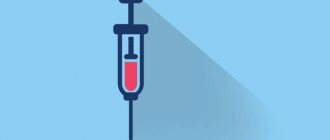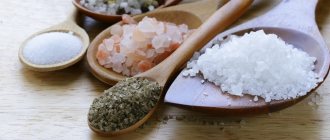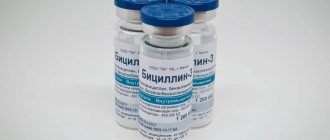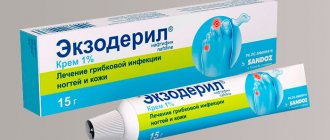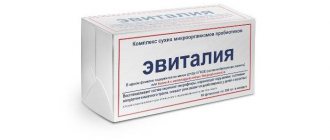Benzylpenicillin sodium salt - drug (powder), (pharmacological group - antimicrobial drugs for systemic use). The instructions for use highlight the following features:
How to dissolve vascular plaques, normalize blood circulation, blood pressure and forget the way to the pharmacy
- Sold only with a doctor's prescription
- During pregnancy: with caution
- When breastfeeding: contraindicated
- If renal function is impaired: with caution
Pharmacodynamics and pharmacokinetics
Benzylpenicillin is a biosynthetic antibiotic and belongs to the group of penicillins . The bactericidal effectiveness of the drug is manifested due to its ability to inhibit the synthesis of bacterial cell .
The effect of the drug is detrimental to gram-positive microorganisms: staphylococci , causative agents of diphtheria and anthrax , streptococci ; gram-negative bacteria: pathogens of gonorrhea and meningococcal infection ; spore-forming anaerobic rods; as well as spirochetes and actinomycetes .
Strains of staphylococci that produce penicillinase are not sensitive to the effects of benzylpenicillin .
When the drug is administered intramuscularly, TCmax in plasma is observed after 20-30 minutes. Binding to plasma proteins occurs by 60%. The antibiotic has good penetration into tissues, biological fluids and organs of the human body, with the exception of cerebrospinal fluid , prostate gland and eye tissues, and passes through the BBB . Excretion is carried out in unchanged form by the kidneys. T1/2 fluctuates between 30-60 minutes, with kidney pathologies it can increase to 4-10 hours or even more.
Pharmacological properties
Pharmacodynamics
Benzylpenicillin sodium salt is an antibacterial drug from the group of biosynthetic (natural) penicillins, has a bactericidal effect, and is destroyed by penicillinase. The mechanism of action of its active substance is due to inhibition of transpeptidase and inhibition of the formation of peptide bonds. By disrupting the late stages of cell wall peptidoglycan synthesis, it causes lysis of dividing bacterial cells.
Benzylpenicillin is active against the following pathogens:
- gram-positive microorganisms: Bacillus anthracis, Streptococcus speciales (spp.) (including Streptococcus pneumoniae), Staphylococcus spp. (non-penicillinase-forming), Corynebacterium spp. (including Corynebacterium diphtheriae), Actinomyces spp.;
- gram-negative microorganisms: Neisseria meningitidis, Neisseria gonorrhoeae, Treponema spp., Spirochaetes class.
Resistance to benzylpenicillin sodium salt is demonstrated by microorganisms that produce penicillinase: Staphylococcus spp., most viruses, gram-negative bacteria, including Pseudomonas aeruginosa, Rickettsia spp., protozoa.
In recent years, the sensitivity of hemolytic streptococci, gonococci, staphylococci and pneumococci to benzylpenicillin has changed.
Pharmacokinetics
After intramuscular administration, the maximum concentration of benzylpenicillin in the blood plasma is reached after approximately 0.5 hours.
Plasma protein binding is 60%.
Benzylpenicillin penetrates the placental barrier, and in case of inflammation of the meningeal membranes, it overcomes the blood-brain barrier. Widely distributed in tissues, organs and body fluids (except eye tissue, cerebrospinal fluid and prostate gland).
It is excreted unchanged through the kidneys. The half-life (T1/2) is 0.5–1 hour, in case of renal failure – from 4 to 10 hours or more.
Indications for use
Benzylpenicillin is indicated for the treatment of diseases that were caused by microorganisms sensitive to its effects:
- focal/lobar pneumonia ;
- syphilis;
- pleural empyema;
- scarlet fever;
- sepsis;
- diphtheria;
- septicemia;
- erysipelas;
- pyemia;
- anthrax;
- septic endocarditis (subacute and acute);
- actinomycosis;
- meningitis;
- ENT infections;
- osteomyelitis;
- gonorrhea;
- biliary and urinary tract infections;
- blenorrhea;
- angina;
- infections of mucous membranes and soft tissues;
- purulent skin infections;
- purulent-inflammatory infections in gynecologists.
Side effects
candidiasis of the oral cavity and/or vagina , may occur .
From the gastrointestinal tract, a feeling of nausea , diarrhea , and sometimes vomiting .
On the part of the central nervous system, especially when using high doses of the drug or when performing endolumbar injections, the formation of neurotoxic phenomena , such as an increase in reflex excitability, convulsions , nausea, symptoms of meningism , vomiting, coma .
The observed allergic manifestations included fever , skin rash and/or rash on mucous membranes, urticaria , joint pain, angioedema , eosinophilia anaphylactic shock , which can be fatal is also possible .
Side effects
1.Digestive tract:
- Nausea;
- Vomit;
- Diarrhea;
- Stomatitis;
- Glossitis (inflammation of the tongue).
2.Central nervous system:
- Reflex excitability;
- Symptoms of meningism (headache, nausea, vomiting);
- Convulsions;
- Coma.
3.Allergic reactions:
- Increased body temperature;
- Hives;
- Rash on the skin and mucous membranes;
- Joint pain;
- Quincke's edema;
- Eosinophilia (the number of eosinophils in the blood is higher than normal);
- Anaphylactic shock;
- Exudative erythema multiforme;
- Exfoliative dermatitis;
- An attack of bronchial asthma;
- Serum-like reactions;
- Allergic myocarditis.
4.Other:
- Candidiasis of the vagina or oral cavity;
- Jarisch-Herxheimer reaction (fever, chills, low blood pressure, tachycardia, nausea, headache, muscle pain). Usually occurs in the treatment of syphilis and other diseases caused by spirochetes;
- Interstitial nephritis;
- Anemia;
- Leukopenia (the level of white blood cells in the blood is below normal);
- Thrombocytopenia (the level of platelets in the blood is below normal);
- Violation of the pumping function of the myocardium (only for sodium salt of benzylpenicillin);
- Arrhythmias, cardiac arrest, hyperkalemia (only for benzylpenicillin potassium salt);
- Oliguria (small amount of urine excreted);
- Albuminuria (protein in the urine) and hematuria (blood in the urine) develop only against the background of existing nephropathy.
Benzylpenicillin sodium salt, instructions for use
The dosage regimen of benzylpenicillin is determined individually. Intramuscular (IM), subcutaneous (SC), intravenous (IV) and endolumbar administration of the drug is practiced.
In the case of intramuscular and intravenous injections, the daily dosage for adult patients varies between 250,000-60,000,000 units. As a rule, benzylpenicillin sodium salt 1,000,000 units is used.
The daily pediatric dose is calculated based on the child's weight and is 50,000-100,000 units per kilogram of weight for the age of up to 1 year and 50,000 units per kilogram of weight for the age after the 1st year. According to indications, it is possible to increase the daily dosage to 300,000 units per kilogram of weight, for vital indications - up to 500,000 units per kilogram of weight. The drug is administered 4-6 times every 24 hours.
Basically, for intravenous and intramuscular injections, the powder is diluted in water d/in . Also, for intramuscular use, it can be dissolved in novocaine (0.5%), with a preliminary test to determine the patient’s sensitivity to it. Before diluting benzylpenicillin sodium salt, you should visually check the powder for the content of foreign inclusions. The prepared solution can be stored for no more than 24 hours.
Subcutaneous administration of an antibiotic is practiced to puncture infiltrates . In this case, dissolve 100,000-200,000 units of powder in 1 ml of novocaine (0.25-0.5%).
Endolumbar injections are performed based on the disease and its severity. Adult doses are 5000-10000 units, children's doses are 2000-5000 units. In this case, the powder is diluted with water d/in . or sodium chloride (0.9%) at the rate of 1000 units per 1 ml of solvent. Before administration, depending on intracranial pressure , 5-10 ml of CSF and added to the prepared drug solution in a 1:1 ratio.
The minimum duration of treatment is limited to 7 days, the maximum can last up to 2 months or even longer.
pharmachologic effect
Antibiotic of the group of biosynthetic penicillins. It has a bactericidal effect by inhibiting the synthesis of the cell wall of microorganisms.
Active against gram-positive bacteria: Staphylococcus spp., Streptococcus spp. (including Streptococcus pneumoniae), Corynebacterium diphtheriae, Bacillus anthracis; gram-negative bacteria: Neisseria gonorrhoeae, Neisseria meningitidis; anaerobic spore-forming rods; as well as Actinomyces spp., Spirochaetaceae.
Strains of Staphylococcus spp. that produce penicillinase are resistant to the action of benzylpenicillin. Destroys in an acidic environment.
The novocaine salt of benzylpenicillin, compared to the potassium and sodium salts, is characterized by a longer duration of action.
Overdose
In case of overdose of benzylpenicillin, its toxic effect on the central nervous system was noted (mainly when administered endolumbarally). The observed symptoms were manifested by reflex agitation , nausea, headaches , myalgia , vomiting, convulsions , meningism , arthralgia, coma .
In this situation, further injections are stopped and symptomatic treatment is prescribed, including hemodialysis . In this case, special attention is paid to the water-electrolyte state.
special instructions
Benzylpenicillin is prescribed with extreme caution to patients with kidney pathologies , heart failure , allergies (especially drug allergies ), as well as hypersensitivity to cephalosporins (due to the possible formation of cross-reactions).
In case of zero effect of therapy carried out over 3-5 days, the possibility of combination with other drugs or the prescription of other antibiotics .
During treatment fungal superinfections , and therefore it is advisable to use antifungal agents .
It should be remembered that early interruption of treatment with benzylpenicillin or its use in subtherapeutic doses contributes to the formation of resistant bacterial strains .
Action
All varieties of benzylpenicillin have a detrimental effect on the following types of pathogenic microorganisms:
- Gonococci (Neisseria gonorrheae);
- Meningococci (Neisseria meningitidis);
- Pneumococci;
- Staphylococci that do not produce penicillinase;
- Streptococci of groups A, B, C, G, L and M;
- Enterococci;
- Alcaligenes faecalis;
- Actinomycetes;
- Bacillus anthracis;
- Clostridiae;
- Corynebacterium diphtheriae;
- Erysipelothrix insidosa;
- Escherichia coli;
- Fusobacterium fusiforme;
- Leptospirae;
- Listeia monocytogenes;
- Pasteurella multocida;
- Spirilllim minus;
- Spirochaetaceae (causative agents of syphilis, yaws, Lyme borreliosis, etc.);
- Streptobacillus moniliformis;
- Treponema pallidum.
Analogs
Level 4 ATC code matches:
Bicillin
Phenoxymethylpenicillin
Extensillin
Retarpen
Benzylpenicillin
Sulacillin
- Bicillin;
- Phenoxymethylpenicillin;
- Benzicillin;
- Ospen;
- Moldamin;
- Retarpen;
- Star Pen.
Benzylpenicillin - analogues
- Azlocillin sodium salt lyophilisate for the preparation of a solution for intravenous administration;
- Amosin tablets, capsules and powder for the preparation of solution for oral administration;
- Ampicillin capsules, tablets, granules for the preparation of a suspension for oral administration, powder for the preparation of a solution for injection;
- Gramox-D powder for the preparation of suspension for oral administration;
- Carbenicillin disodium salt powder for solution for injection;
- Oxacillin capsules, tablets, powder for solution for injection;
- Ospamox capsules, tablets and powder for the preparation of suspension for oral administration;
- Ospen 750 syrup;
- Standacillin capsules;
- Star-Pen granules for the preparation of a suspension for oral administration;
- Phenoxymethylpenicillin dragees, tablets, granules and powder for the preparation of suspension for oral administration;
- Hiconcil capsules and powder for the preparation of suspension for oral administration;
- Ecobol tablets.
Reviews
On various Internet resources you can find both negative and positive reviews about benzylpenicillin sodium salt . When the drug is used against microorganisms , the treatment almost always shows good results and, on the contrary, when using Benzylpenicillin to destroy strains of bacteria , at best, it is wasted. In this regard, for any bacterial infection causative agent before starting therapy and only then prescribe an antibiotic .
Drug interactions
The combination of benzylpenicillin sodium salt with aminoglycosides, macrolides, and sulfonamide agents produces a synergistic effect.
An increase in the activity of benzylpenicillin is caused by beta-lactamase inhibitors.
With the simultaneous use of other bacteriostatic drugs (including chloramphenicol), the therapeutic effect of the drug is reduced.
With concomitant therapy with nonsteroidal anti-inflammatory drugs (NSAIDs), diuretics, tubular secretion blockers, allopurinol, T1/2 of benzylpenicillin increases, its concentration in the blood plasma and the risk of toxicity increases. In addition, allopurinol increases the risk of developing skin rashes.
Combining benzylpenicillin sodium salt with NSAIDs, ethinyl estradiol is not recommended. The contraceptive effect of oral contraceptives may be reduced.
The use of benzylpenicillin increases the effect of indirect anticoagulants, decreases clearance and increases the toxicity of methotrexate.
Mixing benzylpenicillin in the same container with other drugs is not allowed.
Sodium-containing solutions with glucose, including Ringer's solution, should not be used to dissolve the powder.
The incompatibility of benzylpenicillin sodium salt with sympathomimetic amines and metal ions should be taken into account.
Price, where to buy
The price for benzylpenicillin sodium salt, 1,000,000 units, is 6-7 rubles per bottle.
- Online pharmacies in UkraineUkraine
- Online pharmacies in KazakhstanKazakhstan
PaniPharmacy
- Benzylpenicillin bottle Benzylpenicillin sodium salt powder for injection 1000000IU Ukraine, Kievmedpreparat OJSC
11 UAH.order
show more
Similar drugs:
- Augmentin Oral tablets
- Tea tree DN Ointment for external use
- Augmentin Powder for suspension for oral administration
- Bactrim Oral suspension
- Dioxydin Mouth rinse solution
- Pancef Oral tablets
- Nifuroxazide (Nifuroxazide) Oral tablets
- Cifran OD Oral tablets
- Pancef Granules for the preparation of suspension for oral administration
- Augmentin ES Powder for oral solution
** The Drug Directory is intended for informational purposes only. For more complete information, please refer to the manufacturer's instructions. Do not self-medicate; Before starting to use the drug Benzylpenicillin sodium salt, you should consult a doctor. EUROLAB is not responsible for the consequences caused by the use of information posted on the portal. Any information on the site does not replace medical advice and cannot serve as a guarantee of the positive effect of the drug.
Are you interested in the drug Benzylpenicillin sodium salt? Do you want to know more detailed information or do you need a doctor's examination? Or do you need an inspection? You can make an appointment with a doctor - the Euro lab is always at your service! The best doctors will examine you, advise you, provide the necessary assistance and make a diagnosis. You can also call a doctor at home . Euro lab clinic is open for you around the clock.
** Attention! The information presented in this medication guide is intended for medical professionals and should not be used as a basis for self-medication. The description of the drug Benzylpenicillin sodium salt is provided for informational purposes and is not intended for prescribing treatment without the participation of a doctor. Patients need to consult a specialist!
If you are interested in any other drugs and medications, their descriptions and instructions for use, information about the composition and form of release, indications for use and side effects, methods of use, prices and reviews of drugs, or you have any other questions and suggestions - write to us, we will definitely try to help you.
